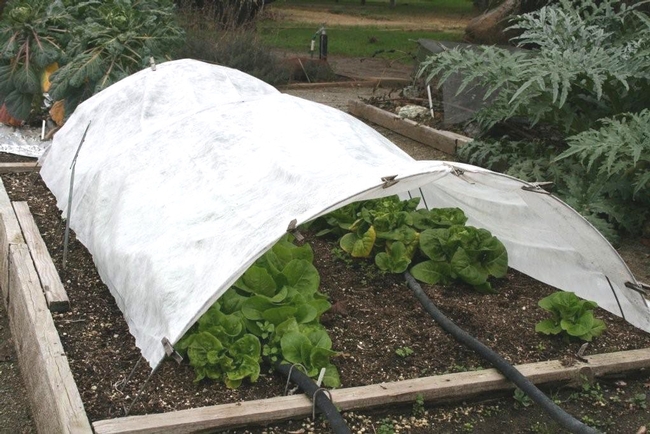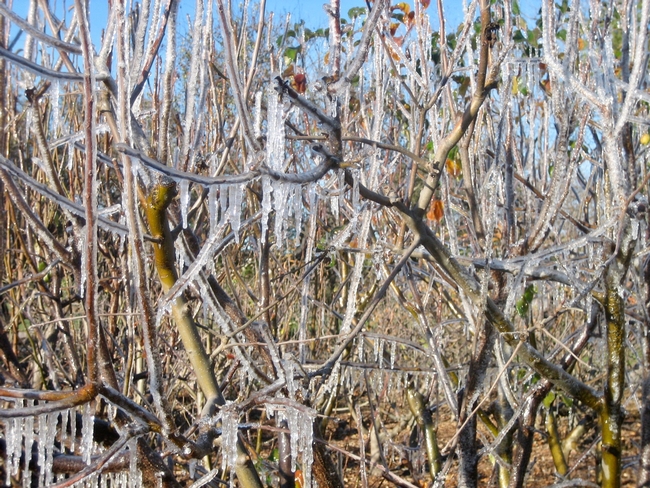Sheltering fragile plants this winter

In the Bay Area we are also fond of some non-native but wonderful plants. Some are particularly susceptible to frost injuries. So this winter, as you reach for that big soft blanket folded up at the end of our couch, don't forget those beauties in your garden that need a little warming up as well. If you have citrus, bougainvillea, succulents, avocados, or fuchsias in your garden then I'm talking to you. And, unless you're willing to share your blanket (answer: no) then you should have a frost plan. An ounce of prevention for your plants will keep you warm and cozy on the couch. So, take a few minutes to prepare for the next time you find Jack Frost nipping at your rose (couldn't help it…and, side note, roses are very hardy and do not need protection):
- Water the ground around your plants thoroughly to moderate the soil temperature and protect the root zone.
- Wrap (non-LED) holiday lights around the branches of your shrubs and small trees. The small amount of heat they give off is often just enough to ward off the cold. And they're just so darn festive!
- If you haven't yet thrown out your Christmas tree, cut off the branches and pile them up at the base of your plants to keep them cozy. Any other spruce/pine boughs will do.
- Purchase floating row cover from a garden supply store or forage burlap sacks from your local coffee roaster. Wrap and/or drape either of them lightly over your plants. Then enjoy a cup of coffee.
- Bring potted succulents or other tender plants up on the porch where they can bask in the radiant heat of your house.
- Build an elaborate PVC or wood frame around your plants and drape plastic over them. No, on second thought, don't do this. Choose plants that are more suited for your area and you can avoid this all together!
And now, grab that blanket on the couch and sing with me…baby (kale) it's cold outside…
by UC Master Gardener Cayce Hill
This article first appeared in the January 20 issue of the Morgan Hill Times.
Winter frost can damage and even kill your plants

Citrus, succulents, newly planted or tender perennials, and many tropical and subtropical plants all are vulnerable.
Frost damage occurs when the water inside the cells of a plant freeze, causing damage to the cellular walls, which degrades the overall health of the plant. Affected plants will wilt and in severe or prolong periods of frost, die.
Shoots, buds and flowers will wither and turn brown or black as if they have been scorched. Even bark can crack or split and die off.
Young, newly planted, specimens are especially vulnerable.
We already have had several days of frost and freeze here in the Bay Area, and it looks like more is on the way. So, how do you protect your prized citrus, succulents, rhododendrons and azaleas?
- If a severe freeze, or multiple days of below freezing weather is expected, water 2 to 3 days ahead of time. This will increase the soil's ability to retain and give off heat.
- Wrapping trunks of young trees with blankets, towels or piping insulation will provide added protection.
- If you are doing container gardening and are able to pull pots into the garage, shed or other enclosed area, that would be ideal. Otherwise, move them up against the side of the house or garage, preferably beneath an overhang.
- Stringing your plants with old-fashioned, incandescent Christmas lights –not LEDs — can be very helpful. Covering the lighted plants with frost cloth, sheets or blankets will add 4 to 8 degrees of protection, enough to keep most plants alive.
- Frost cloth is lightweight enough to leave on for several days, however heavier covers should be removed each day once the temperature has warmed up, and then reapplied each night before sunset.
Make sure the cover goes all the way to ground in order to capture the radiant heat from the soil. Also, stake heavier covers so that the weight won't break branches, damage the leaves or suffocate the plant. You can also use inverted boxes, buckets and plant pots. - Adding a 2- to 3-inch layer of mulch around your plants can also help, but be sure to stay several inches away from the trunk or stem; mulching too close will cause the plant to rot.
- There are many varieties of foliar sprays available today that claim to protect against frost. Although recent field trials have shown no real harm in using them, they also show have found little to no actual protection from these products. You are better off using other methods to keep your plants safe.
- Wait until all chance of frost has passed before trimming off any damaged or diseased branches. Pruning too soon can cause significantly more trauma, even death, to a young, vulnerable plant that might otherwise have recovered in the spring.
by UC Master Gardener Rebecca Jepsen
This article first appeared in the January 8 issue of the San Jose Mercury News.

